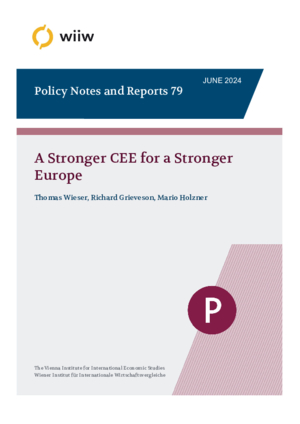A Stronger CEE for a Stronger Europe
Richard Grieveson, Mario Holzner and Thomas Wieser
wiiw Policy Note/Policy Report No. 79, June 2024
26 pages including 4 Figures
We discuss past performance and future challenges for the countries of Central and Eastern Europe (CEE). We highlight the successful convergence process of those countries, not least thanks to their integration into European and global value chains. As the external environment changes, so policies must change in order to maintain the momentum. A strong European Union also presupposes a strong and vibrant CEE. The policy recommendations in the areas we have covered in this contribution include: national reform programmes that promote innovation, competitiveness, and transparent institutions; a larger EU budget for European public goods; shadow policies for euro accession by CEE non-euro economies; accession to the banking union by CEE non-euro countries; deepening of home/host cooperation with the assistance of the European Banking Authority to enable freer movement of capital; high-quality implementation of anti-money-laundering processes and institutions; promotion of regional cooperation in areas such as withholding tax, convergence of rules on accounting and stock exchanges in support of a regional capital market; promotion of deeper national capital markets by boosting the second and third pillars of pension systems, while retaining their pay-as-you-go systems; regional cooperation among venture capital funds, supported by the European Investment Fund; investment in science, technology, engineering, and mathematics (STEM) education and establishment of a leading university to retain talent and foster innovation; implementation of a modern industrial policy promoting infrastructure and know-how for the green and digital transformation; mitigating the demographic challenges will require a mixture of automation, greater immigration and higher participation rates; promotion of a high degree of flexibility in labour markets, in order to facilitate shifts away from sectors that are adversely impacted by the twin transition, and towards more innovative activities; education and training programs for sectors where wage convergence has made most progress, including promotion of labour mobility within CEE to overcome sectoral bottlenecks; provision of family-friendly infrastructure to encourage citizens to remain in their home countries and encourage return migration.
Reference to wiiw databases: wiiw Annual Database
Keywords: European integration, economic convergence, Central and Eastern Europe, European Union, Euro Area, growth model, financial markets
JEL classification: E22, E24, F15, F21, F36, G24, H54, J24, O16, O47
Countries covered: CEE, European Union
Research Areas: Macroeconomic Analysis and Policy, Labour, Migration and Income Distribution, International Trade, Competitiveness and FDI, Sectoral studies
